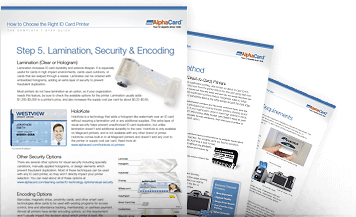Try ID Software for Free
Get 6-week Trial of AlphaCard ID Software
GO TO FREE TRIAL * No credit card neededSmart cards, a term that includes several types of technology, use a microprocessor within an ID card to send and receive data with the card reader. This ability to both read and write to the card is what sets smart cards apart from any other type of encoding, and they can hold over 100 times more data than a magnetic stripe card.
This type of encoding gives you the most flexibility in the amount and type of data you store on the cards, making them ideal for multipurpose ID card programs. Smart card encoding is the most expensive encoding option, but it offers the most storage and security.
Smart card encoding is a feature found in advanced ID card software – if you need to encode these types of cards, look for software upgrade options or professional versions.
Types of Smart Cards
There are two basic types of smart cards, contact and contactless:
- Contact cards have a smart chip embedded in the surface of the card, and it must come into contact with the reader to work
- Contactless cards have a chip and antenna system that can wirelessly send the data to the reader once it comes into range

Smart cards look like normal ID cards, so you do have the option to print on them to add your business logo or cardholder information. If you do print on the cards however, you should only use a reverse transfer printer – technology cards may have uneven surface that can damage the printhead on other types of printers. Learn more about reverse transfer printing.
Smart Cards Are Best For:
- Cashless Payment Cards
- Data & Information Storage
- Multifunctional ID Programs. Public Transportation Passes

How Smart Cards Work
Contact cards use an embedded chip to send and receive data. When the card is placed in the reader the circuit on the chip is closed and the data can be read. This allows to cards to store your information, process data, and perform tasks.
Contactless cards, on the other hand, use Radio Frequency Identification (RFID) to send and receive data. They only need to come within range of the reader to work, although the range distance will vary by system. This makes contactless cards longer lasting than others because they are not swiped, preventing most of the wear and tear that damages other cards.




